FDS308 Food Technology Assignment: Food Preservation & Liquid Foods
VerifiedAdded on 2023/06/12
|24
|3727
|312
Homework Assignment
AI Summary
This assignment solution covers key concepts in food science, including food preservation methods like heat processing, concentration, and drying. It addresses the principles of pasteurization and sterilization, detailing the importance of parameters like z-value and F0 value. The document explores various concentration techniques such as evaporation, membrane processing, and freeze concentration, highlighting their applications and limitations. Furthermore, it delves into the technology of liquid foods, focusing on milk and dairy products, fats and oils, and alcoholic beverages, including butter production and beer manufacturing. The solution also includes calculations related to food processing, such as determining ingredient ratios for beef sausage production and D-value calculation for bacterial reduction. Desklib offers a wealth of similar solved assignments and study resources to aid students in their academic pursuits.

Name of the student:
Institution name:
Course of study:
Date:
Food Science Answers
Institution name:
Course of study:
Date:
Food Science Answers
Paraphrase This Document
Need a fresh take? Get an instant paraphrase of this document with our AI Paraphraser
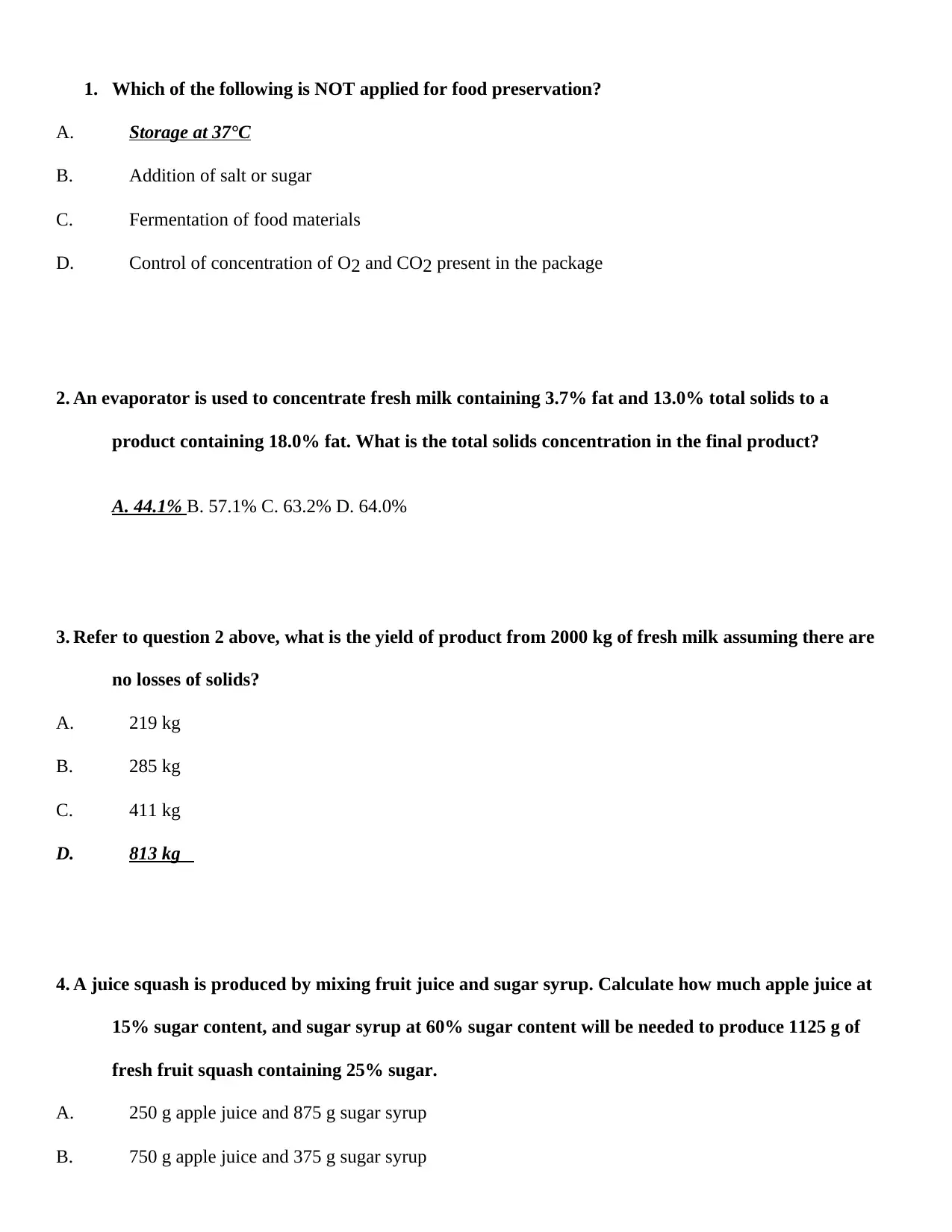
1. Which of the following is NOT applied for food preservation?
A. Storage at 37°C
B. Addition of salt or sugar
C. Fermentation of food materials
D. Control of concentration of O2 and CO2 present in the package
2. An evaporator is used to concentrate fresh milk containing 3.7% fat and 13.0% total solids to a
product containing 18.0% fat. What is the total solids concentration in the final product?
A. 44.1% B. 57.1% C. 63.2% D. 64.0%
3. Refer to question 2 above, what is the yield of product from 2000 kg of fresh milk assuming there are
no losses of solids?
A. 219 kg
B. 285 kg
C. 411 kg
D. 813 kg
4. A juice squash is produced by mixing fruit juice and sugar syrup. Calculate how much apple juice at
15% sugar content, and sugar syrup at 60% sugar content will be needed to produce 1125 g of
fresh fruit squash containing 25% sugar.
A. 250 g apple juice and 875 g sugar syrup
B. 750 g apple juice and 375 g sugar syrup
A. Storage at 37°C
B. Addition of salt or sugar
C. Fermentation of food materials
D. Control of concentration of O2 and CO2 present in the package
2. An evaporator is used to concentrate fresh milk containing 3.7% fat and 13.0% total solids to a
product containing 18.0% fat. What is the total solids concentration in the final product?
A. 44.1% B. 57.1% C. 63.2% D. 64.0%
3. Refer to question 2 above, what is the yield of product from 2000 kg of fresh milk assuming there are
no losses of solids?
A. 219 kg
B. 285 kg
C. 411 kg
D. 813 kg
4. A juice squash is produced by mixing fruit juice and sugar syrup. Calculate how much apple juice at
15% sugar content, and sugar syrup at 60% sugar content will be needed to produce 1125 g of
fresh fruit squash containing 25% sugar.
A. 250 g apple juice and 875 g sugar syrup
B. 750 g apple juice and 375 g sugar syrup
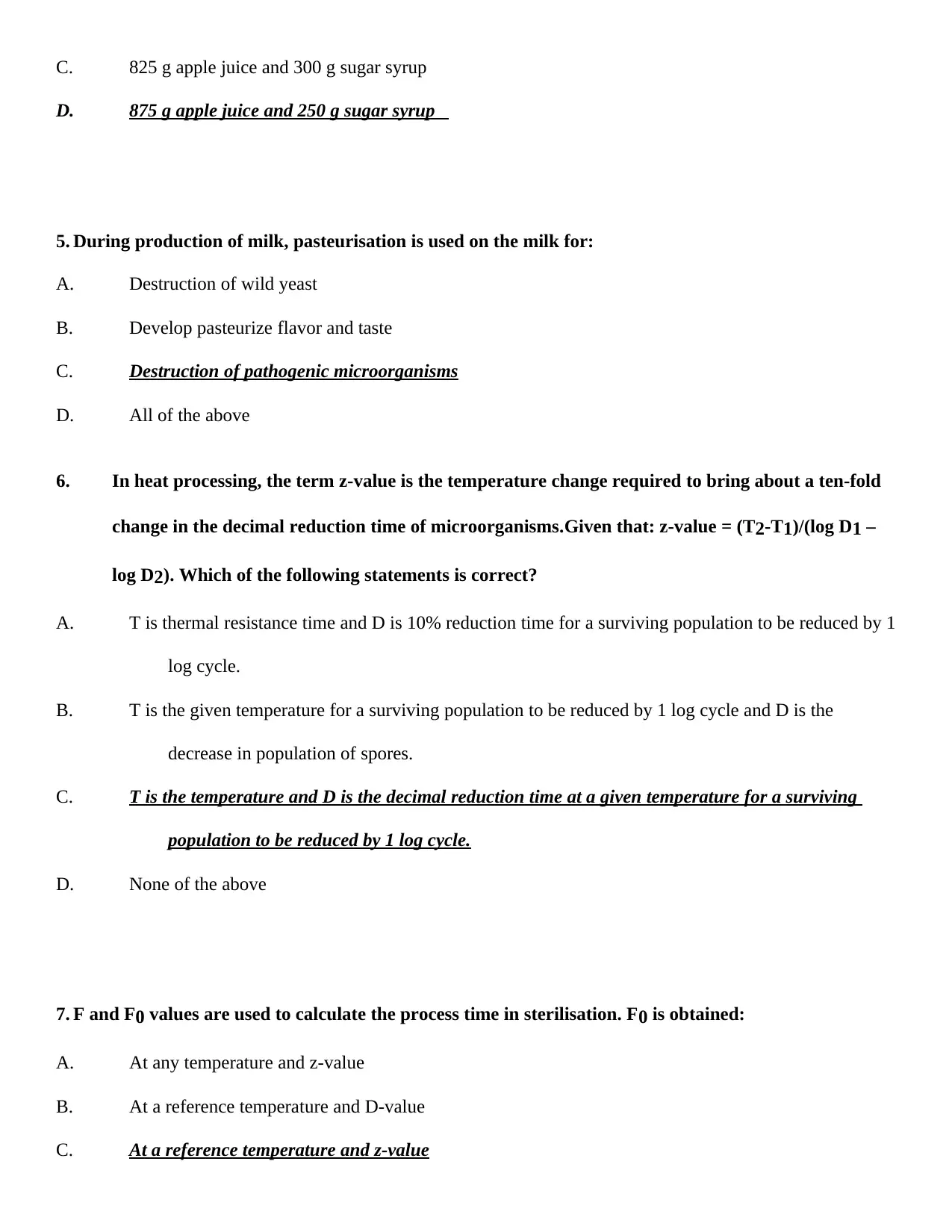
C. 825 g apple juice and 300 g sugar syrup
D. 875 g apple juice and 250 g sugar syrup
5. During production of milk, pasteurisation is used on the milk for:
A. Destruction of wild yeast
B. Develop pasteurize flavor and taste
C. Destruction of pathogenic microorganisms
D. All of the above
6. In heat processing, the term z-value is the temperature change required to bring about a ten-fold
change in the decimal reduction time of microorganisms.Given that: z-value = (T2-T1)/(log D1 –
log D2). Which of the following statements is correct?
A. T is thermal resistance time and D is 10% reduction time for a surviving population to be reduced by 1
log cycle.
B. T is the given temperature for a surviving population to be reduced by 1 log cycle and D is the
decrease in population of spores.
C. T is the temperature and D is the decimal reduction time at a given temperature for a surviving
population to be reduced by 1 log cycle.
D. None of the above
7. F and F0 values are used to calculate the process time in sterilisation. F0 is obtained:
A. At any temperature and z-value
B. At a reference temperature and D-value
C. At a reference temperature and z-value
D. 875 g apple juice and 250 g sugar syrup
5. During production of milk, pasteurisation is used on the milk for:
A. Destruction of wild yeast
B. Develop pasteurize flavor and taste
C. Destruction of pathogenic microorganisms
D. All of the above
6. In heat processing, the term z-value is the temperature change required to bring about a ten-fold
change in the decimal reduction time of microorganisms.Given that: z-value = (T2-T1)/(log D1 –
log D2). Which of the following statements is correct?
A. T is thermal resistance time and D is 10% reduction time for a surviving population to be reduced by 1
log cycle.
B. T is the given temperature for a surviving population to be reduced by 1 log cycle and D is the
decrease in population of spores.
C. T is the temperature and D is the decimal reduction time at a given temperature for a surviving
population to be reduced by 1 log cycle.
D. None of the above
7. F and F0 values are used to calculate the process time in sterilisation. F0 is obtained:
A. At any temperature and z-value
B. At a reference temperature and D-value
C. At a reference temperature and z-value
⊘ This is a preview!⊘
Do you want full access?
Subscribe today to unlock all pages.

Trusted by 1+ million students worldwide
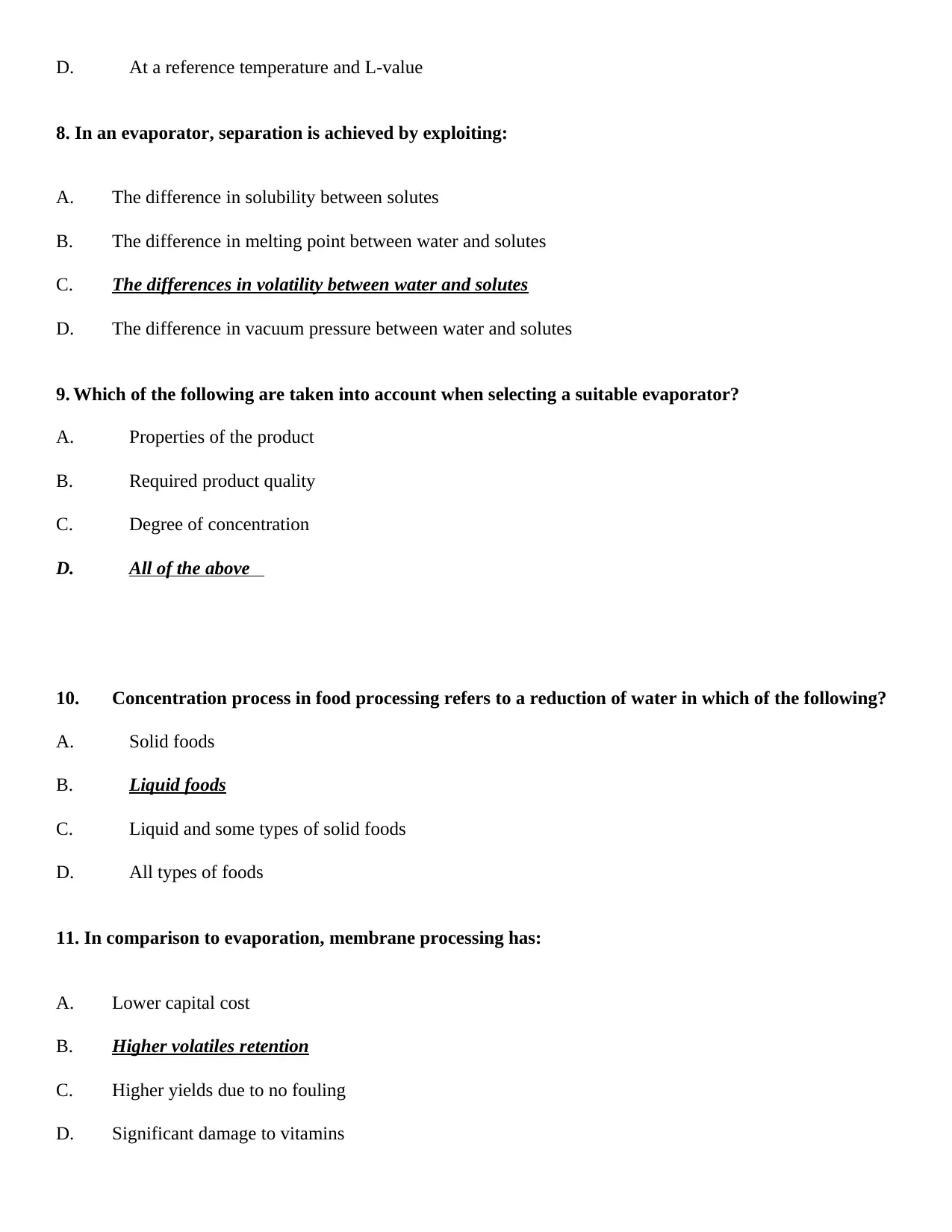
D. At a reference temperature and L-value
8. In an evaporator, separation is achieved by exploiting:
A. The difference in solubility between solutes
B. The difference in melting point between water and solutes
C. The differences in volatility between water and solutes
D. The difference in vacuum pressure between water and solutes
9. Which of the following are taken into account when selecting a suitable evaporator?
A. Properties of the product
B. Required product quality
C. Degree of concentration
D. All of the above
10. Concentration process in food processing refers to a reduction of water in which of the following?
A. Solid foods
B. Liquid foods
C. Liquid and some types of solid foods
D. All types of foods
11. In comparison to evaporation, membrane processing has:
A. Lower capital cost
B. Higher volatiles retention
C. Higher yields due to no fouling
D. Significant damage to vitamins
8. In an evaporator, separation is achieved by exploiting:
A. The difference in solubility between solutes
B. The difference in melting point between water and solutes
C. The differences in volatility between water and solutes
D. The difference in vacuum pressure between water and solutes
9. Which of the following are taken into account when selecting a suitable evaporator?
A. Properties of the product
B. Required product quality
C. Degree of concentration
D. All of the above
10. Concentration process in food processing refers to a reduction of water in which of the following?
A. Solid foods
B. Liquid foods
C. Liquid and some types of solid foods
D. All types of foods
11. In comparison to evaporation, membrane processing has:
A. Lower capital cost
B. Higher volatiles retention
C. Higher yields due to no fouling
D. Significant damage to vitamins
Paraphrase This Document
Need a fresh take? Get an instant paraphrase of this document with our AI Paraphraser
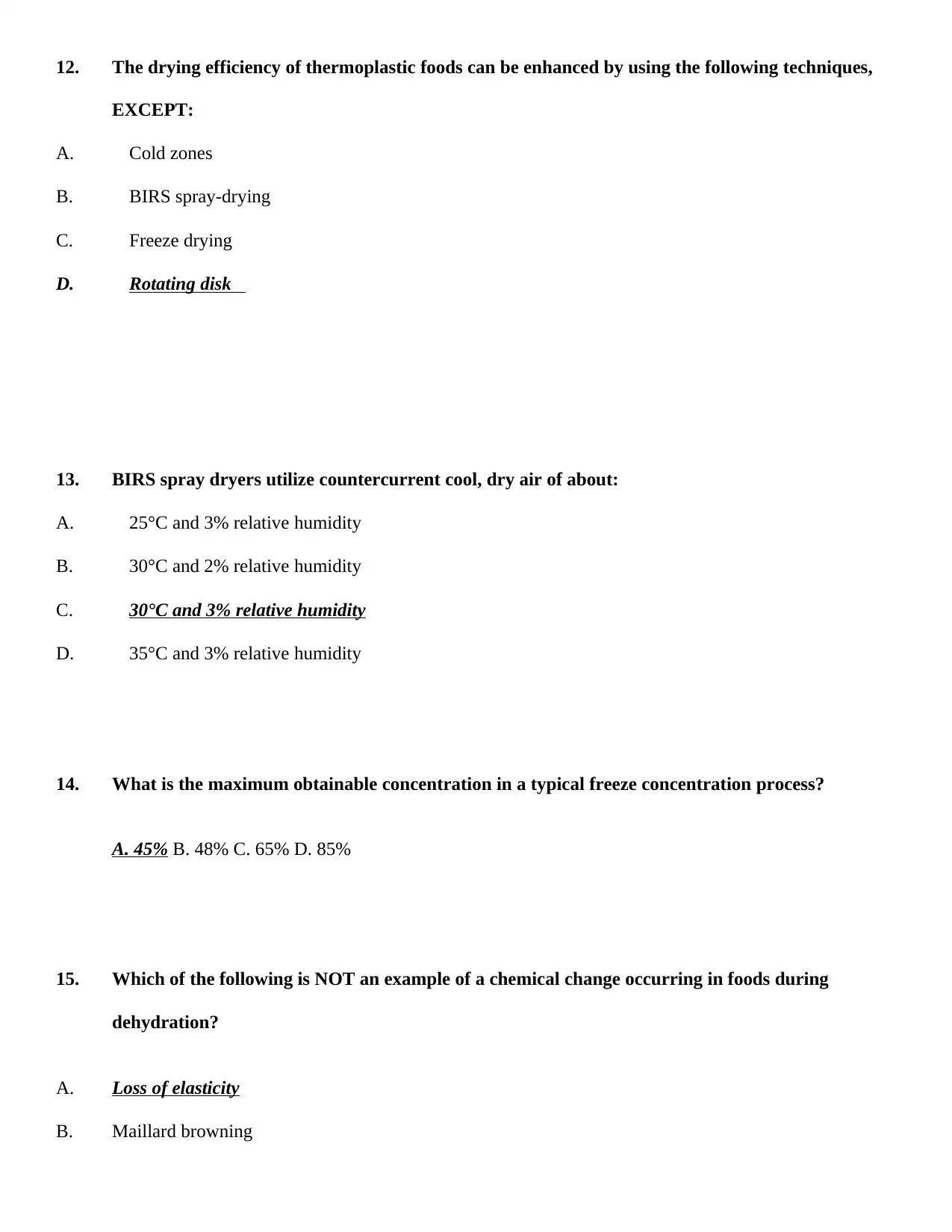
12. The drying efficiency of thermoplastic foods can be enhanced by using the following techniques,
EXCEPT:
A. Cold zones
B. BIRS spray-drying
C. Freeze drying
D. Rotating disk
13. BIRS spray dryers utilize countercurrent cool, dry air of about:
A. 25°C and 3% relative humidity
B. 30°C and 2% relative humidity
C. 30°C and 3% relative humidity
D. 35°C and 3% relative humidity
14. What is the maximum obtainable concentration in a typical freeze concentration process?
A. 45% B. 48% C. 65% D. 85%
15. Which of the following is NOT an example of a chemical change occurring in foods during
dehydration?
A. Loss of elasticity
B. Maillard browning
EXCEPT:
A. Cold zones
B. BIRS spray-drying
C. Freeze drying
D. Rotating disk
13. BIRS spray dryers utilize countercurrent cool, dry air of about:
A. 25°C and 3% relative humidity
B. 30°C and 2% relative humidity
C. 30°C and 3% relative humidity
D. 35°C and 3% relative humidity
14. What is the maximum obtainable concentration in a typical freeze concentration process?
A. 45% B. 48% C. 65% D. 85%
15. Which of the following is NOT an example of a chemical change occurring in foods during
dehydration?
A. Loss of elasticity
B. Maillard browning
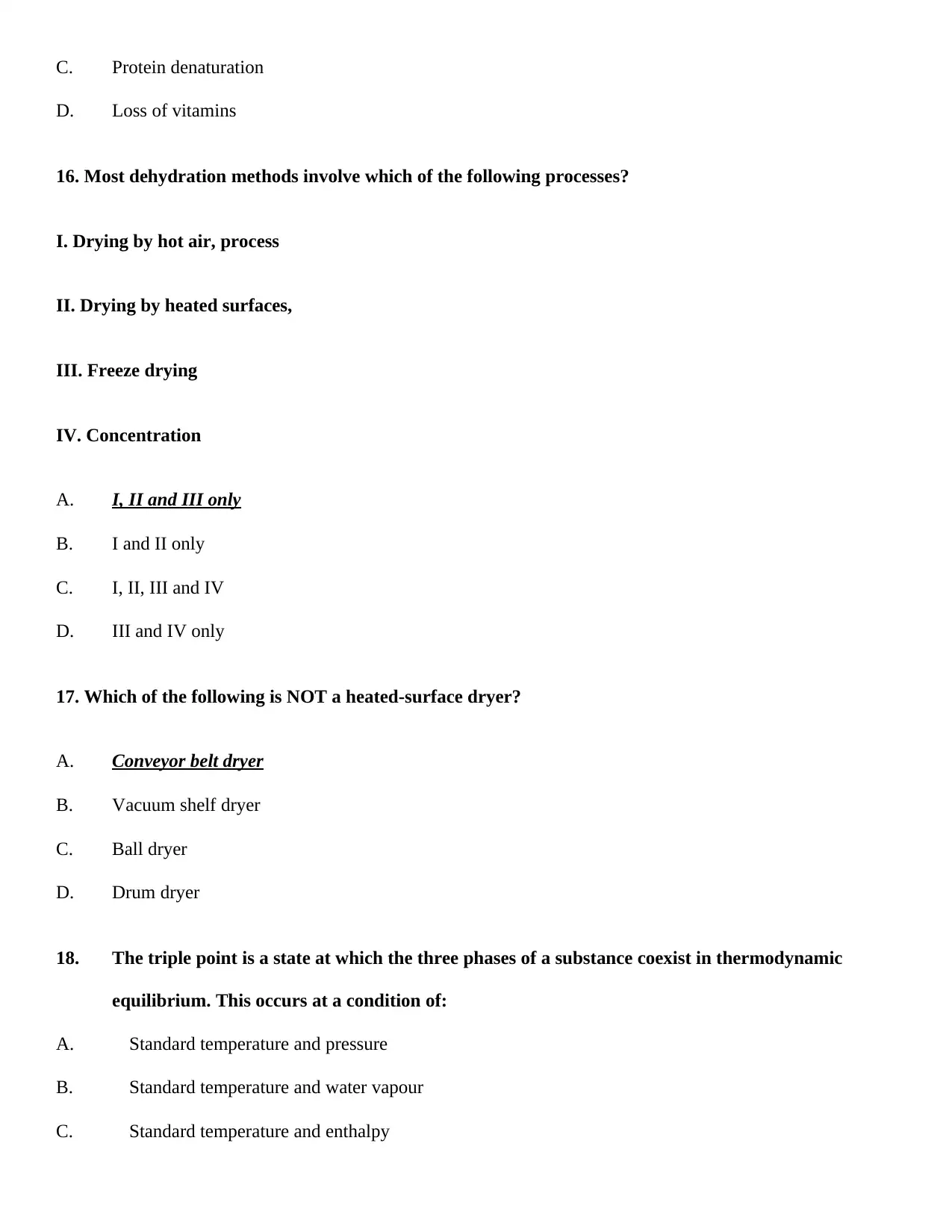
C. Protein denaturation
D. Loss of vitamins
16. Most dehydration methods involve which of the following processes?
I. Drying by hot air, process
II. Drying by heated surfaces,
III. Freeze drying
IV. Concentration
A. I, II and III only
B. I and II only
C. I, II, III and IV
D. III and IV only
17. Which of the following is NOT a heated-surface dryer?
A. Conveyor belt dryer
B. Vacuum shelf dryer
C. Ball dryer
D. Drum dryer
18. The triple point is a state at which the three phases of a substance coexist in thermodynamic
equilibrium. This occurs at a condition of:
A. Standard temperature and pressure
B. Standard temperature and water vapour
C. Standard temperature and enthalpy
D. Loss of vitamins
16. Most dehydration methods involve which of the following processes?
I. Drying by hot air, process
II. Drying by heated surfaces,
III. Freeze drying
IV. Concentration
A. I, II and III only
B. I and II only
C. I, II, III and IV
D. III and IV only
17. Which of the following is NOT a heated-surface dryer?
A. Conveyor belt dryer
B. Vacuum shelf dryer
C. Ball dryer
D. Drum dryer
18. The triple point is a state at which the three phases of a substance coexist in thermodynamic
equilibrium. This occurs at a condition of:
A. Standard temperature and pressure
B. Standard temperature and water vapour
C. Standard temperature and enthalpy
⊘ This is a preview!⊘
Do you want full access?
Subscribe today to unlock all pages.

Trusted by 1+ million students worldwide
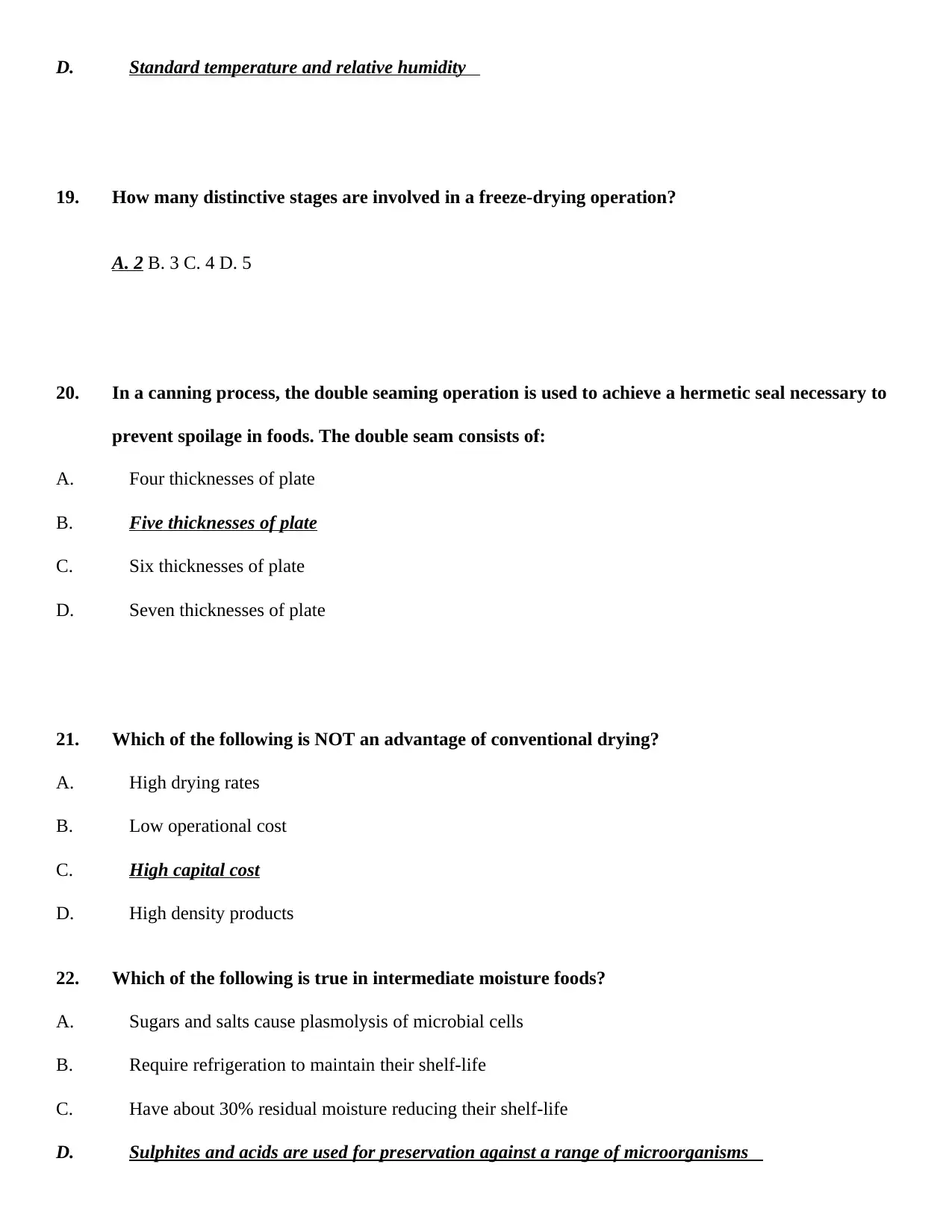
D. Standard temperature and relative humidity
19. How many distinctive stages are involved in a freeze-drying operation?
A. 2 B. 3 C. 4 D. 5
20. In a canning process, the double seaming operation is used to achieve a hermetic seal necessary to
prevent spoilage in foods. The double seam consists of:
A. Four thicknesses of plate
B. Five thicknesses of plate
C. Six thicknesses of plate
D. Seven thicknesses of plate
21. Which of the following is NOT an advantage of conventional drying?
A. High drying rates
B. Low operational cost
C. High capital cost
D. High density products
22. Which of the following is true in intermediate moisture foods?
A. Sugars and salts cause plasmolysis of microbial cells
B. Require refrigeration to maintain their shelf-life
C. Have about 30% residual moisture reducing their shelf-life
D. Sulphites and acids are used for preservation against a range of microorganisms
19. How many distinctive stages are involved in a freeze-drying operation?
A. 2 B. 3 C. 4 D. 5
20. In a canning process, the double seaming operation is used to achieve a hermetic seal necessary to
prevent spoilage in foods. The double seam consists of:
A. Four thicknesses of plate
B. Five thicknesses of plate
C. Six thicknesses of plate
D. Seven thicknesses of plate
21. Which of the following is NOT an advantage of conventional drying?
A. High drying rates
B. Low operational cost
C. High capital cost
D. High density products
22. Which of the following is true in intermediate moisture foods?
A. Sugars and salts cause plasmolysis of microbial cells
B. Require refrigeration to maintain their shelf-life
C. Have about 30% residual moisture reducing their shelf-life
D. Sulphites and acids are used for preservation against a range of microorganisms
Paraphrase This Document
Need a fresh take? Get an instant paraphrase of this document with our AI Paraphraser
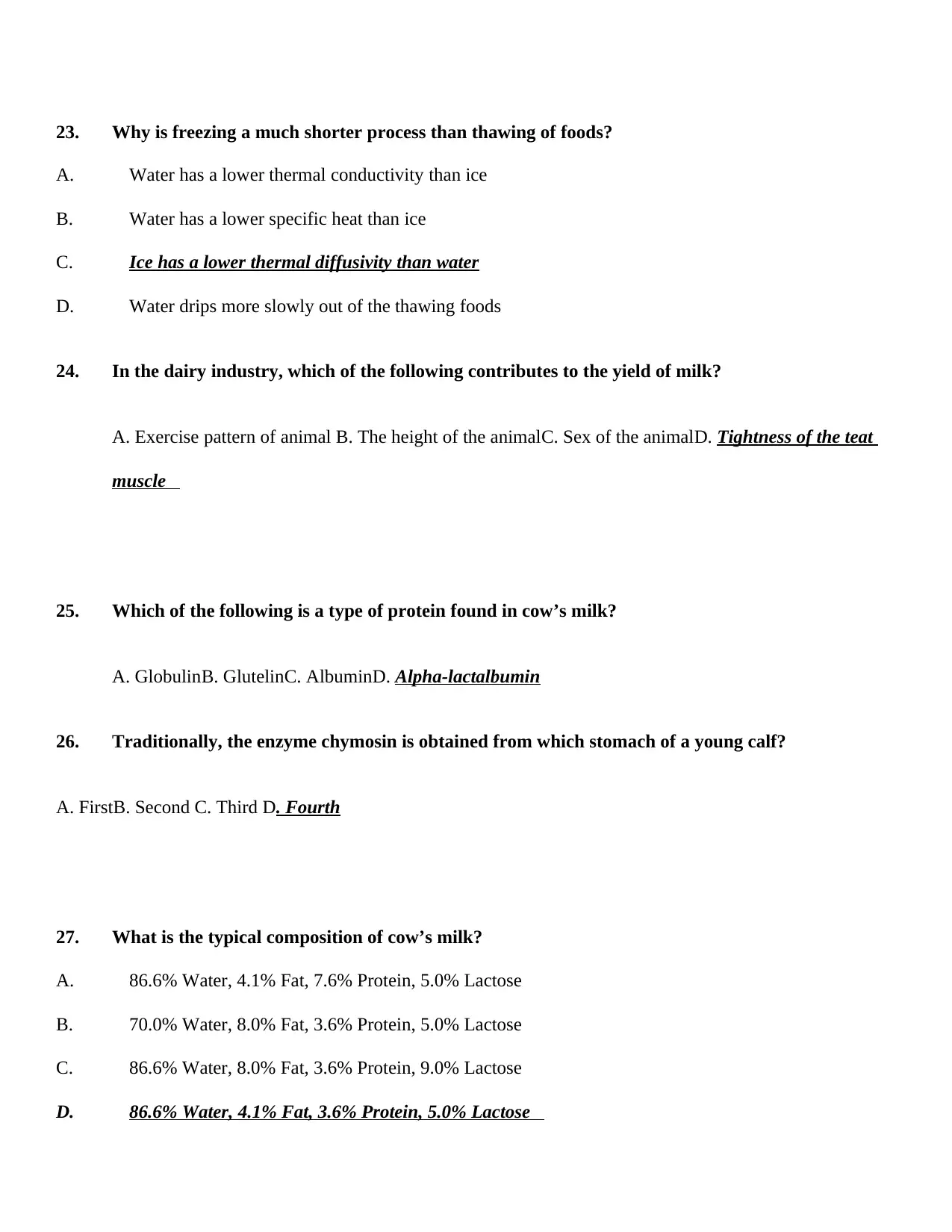
23. Why is freezing a much shorter process than thawing of foods?
A. Water has a lower thermal conductivity than ice
B. Water has a lower specific heat than ice
C. Ice has a lower thermal diffusivity than water
D. Water drips more slowly out of the thawing foods
24. In the dairy industry, which of the following contributes to the yield of milk?
A. Exercise pattern of animal B. The height of the animalC. Sex of the animalD. Tightness of the teat
muscle
25. Which of the following is a type of protein found in cow’s milk?
A. GlobulinB. GlutelinC. AlbuminD. Alpha-lactalbumin
26. Traditionally, the enzyme chymosin is obtained from which stomach of a young calf?
A. FirstB. Second C. Third D. Fourth
27. What is the typical composition of cow’s milk?
A. 86.6% Water, 4.1% Fat, 7.6% Protein, 5.0% Lactose
B. 70.0% Water, 8.0% Fat, 3.6% Protein, 5.0% Lactose
C. 86.6% Water, 8.0% Fat, 3.6% Protein, 9.0% Lactose
D. 86.6% Water, 4.1% Fat, 3.6% Protein, 5.0% Lactose
A. Water has a lower thermal conductivity than ice
B. Water has a lower specific heat than ice
C. Ice has a lower thermal diffusivity than water
D. Water drips more slowly out of the thawing foods
24. In the dairy industry, which of the following contributes to the yield of milk?
A. Exercise pattern of animal B. The height of the animalC. Sex of the animalD. Tightness of the teat
muscle
25. Which of the following is a type of protein found in cow’s milk?
A. GlobulinB. GlutelinC. AlbuminD. Alpha-lactalbumin
26. Traditionally, the enzyme chymosin is obtained from which stomach of a young calf?
A. FirstB. Second C. Third D. Fourth
27. What is the typical composition of cow’s milk?
A. 86.6% Water, 4.1% Fat, 7.6% Protein, 5.0% Lactose
B. 70.0% Water, 8.0% Fat, 3.6% Protein, 5.0% Lactose
C. 86.6% Water, 8.0% Fat, 3.6% Protein, 9.0% Lactose
D. 86.6% Water, 4.1% Fat, 3.6% Protein, 5.0% Lactose
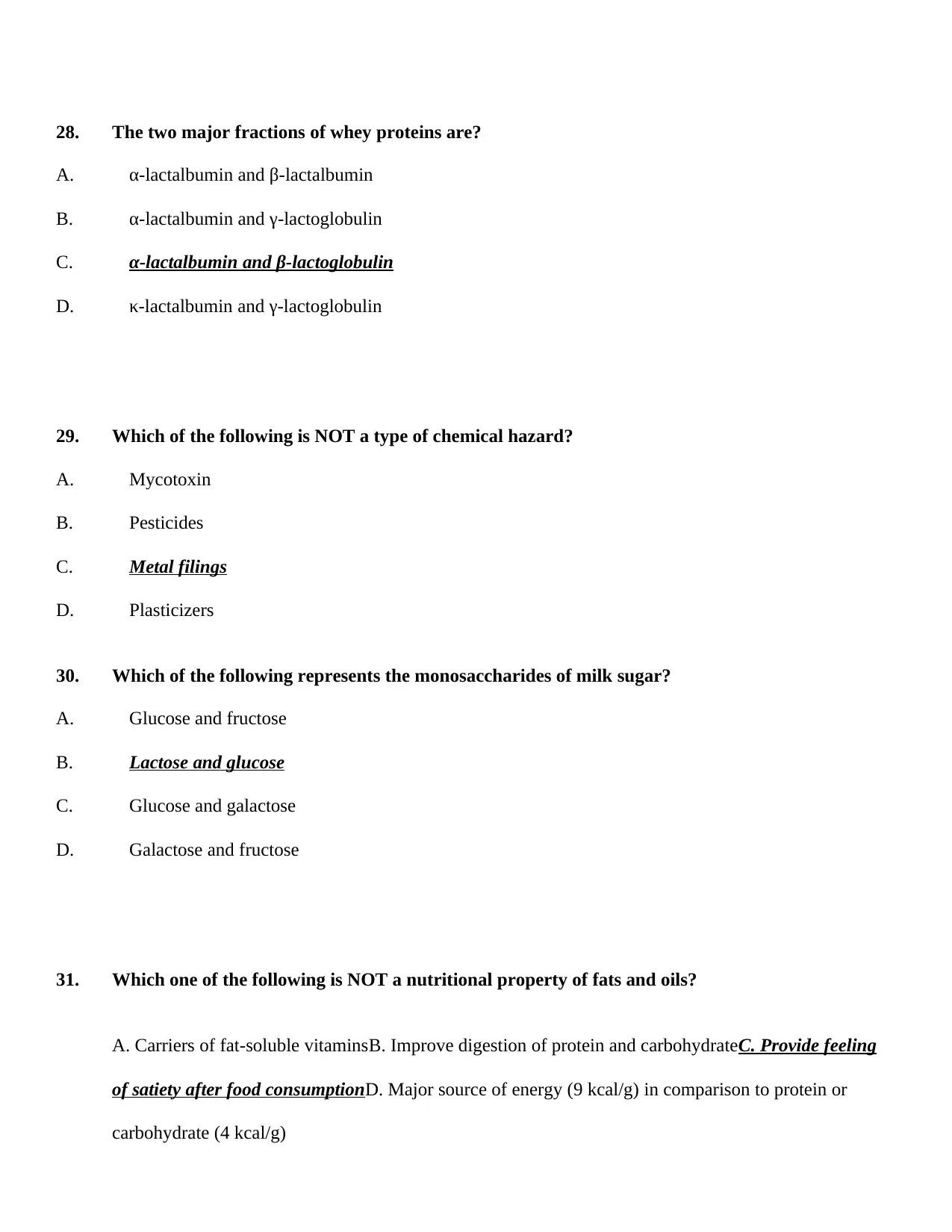
28. The two major fractions of whey proteins are?
A. α-lactalbumin and β-lactalbumin
B. α-lactalbumin and γ-lactoglobulin
C. α-lactalbumin and β-lactoglobulin
D. κ-lactalbumin and γ-lactoglobulin
29. Which of the following is NOT a type of chemical hazard?
A. Mycotoxin
B. Pesticides
C. Metal filings
D. Plasticizers
30. Which of the following represents the monosaccharides of milk sugar?
A. Glucose and fructose
B. Lactose and glucose
C. Glucose and galactose
D. Galactose and fructose
31. Which one of the following is NOT a nutritional property of fats and oils?
A. Carriers of fat-soluble vitaminsB. Improve digestion of protein and carbohydrateC. Provide feeling
of satiety after food consumptionD. Major source of energy (9 kcal/g) in comparison to protein or
carbohydrate (4 kcal/g)
A. α-lactalbumin and β-lactalbumin
B. α-lactalbumin and γ-lactoglobulin
C. α-lactalbumin and β-lactoglobulin
D. κ-lactalbumin and γ-lactoglobulin
29. Which of the following is NOT a type of chemical hazard?
A. Mycotoxin
B. Pesticides
C. Metal filings
D. Plasticizers
30. Which of the following represents the monosaccharides of milk sugar?
A. Glucose and fructose
B. Lactose and glucose
C. Glucose and galactose
D. Galactose and fructose
31. Which one of the following is NOT a nutritional property of fats and oils?
A. Carriers of fat-soluble vitaminsB. Improve digestion of protein and carbohydrateC. Provide feeling
of satiety after food consumptionD. Major source of energy (9 kcal/g) in comparison to protein or
carbohydrate (4 kcal/g)
⊘ This is a preview!⊘
Do you want full access?
Subscribe today to unlock all pages.

Trusted by 1+ million students worldwide
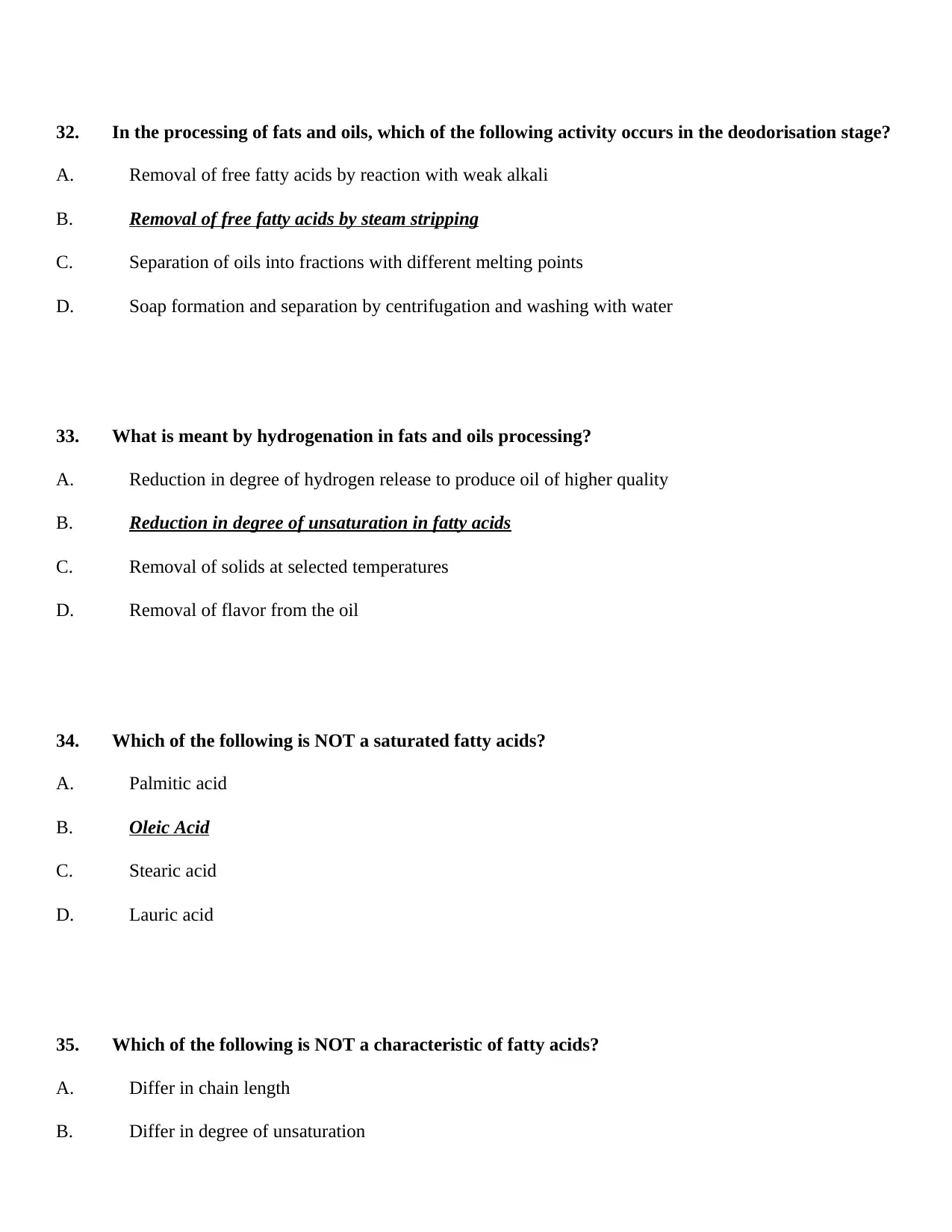
32. In the processing of fats and oils, which of the following activity occurs in the deodorisation stage?
A. Removal of free fatty acids by reaction with weak alkali
B. Removal of free fatty acids by steam stripping
C. Separation of oils into fractions with different melting points
D. Soap formation and separation by centrifugation and washing with water
33. What is meant by hydrogenation in fats and oils processing?
A. Reduction in degree of hydrogen release to produce oil of higher quality
B. Reduction in degree of unsaturation in fatty acids
C. Removal of solids at selected temperatures
D. Removal of flavor from the oil
34. Which of the following is NOT a saturated fatty acids?
A. Palmitic acid
B. Oleic Acid
C. Stearic acid
D. Lauric acid
35. Which of the following is NOT a characteristic of fatty acids?
A. Differ in chain length
B. Differ in degree of unsaturation
A. Removal of free fatty acids by reaction with weak alkali
B. Removal of free fatty acids by steam stripping
C. Separation of oils into fractions with different melting points
D. Soap formation and separation by centrifugation and washing with water
33. What is meant by hydrogenation in fats and oils processing?
A. Reduction in degree of hydrogen release to produce oil of higher quality
B. Reduction in degree of unsaturation in fatty acids
C. Removal of solids at selected temperatures
D. Removal of flavor from the oil
34. Which of the following is NOT a saturated fatty acids?
A. Palmitic acid
B. Oleic Acid
C. Stearic acid
D. Lauric acid
35. Which of the following is NOT a characteristic of fatty acids?
A. Differ in chain length
B. Differ in degree of unsaturation
Paraphrase This Document
Need a fresh take? Get an instant paraphrase of this document with our AI Paraphraser
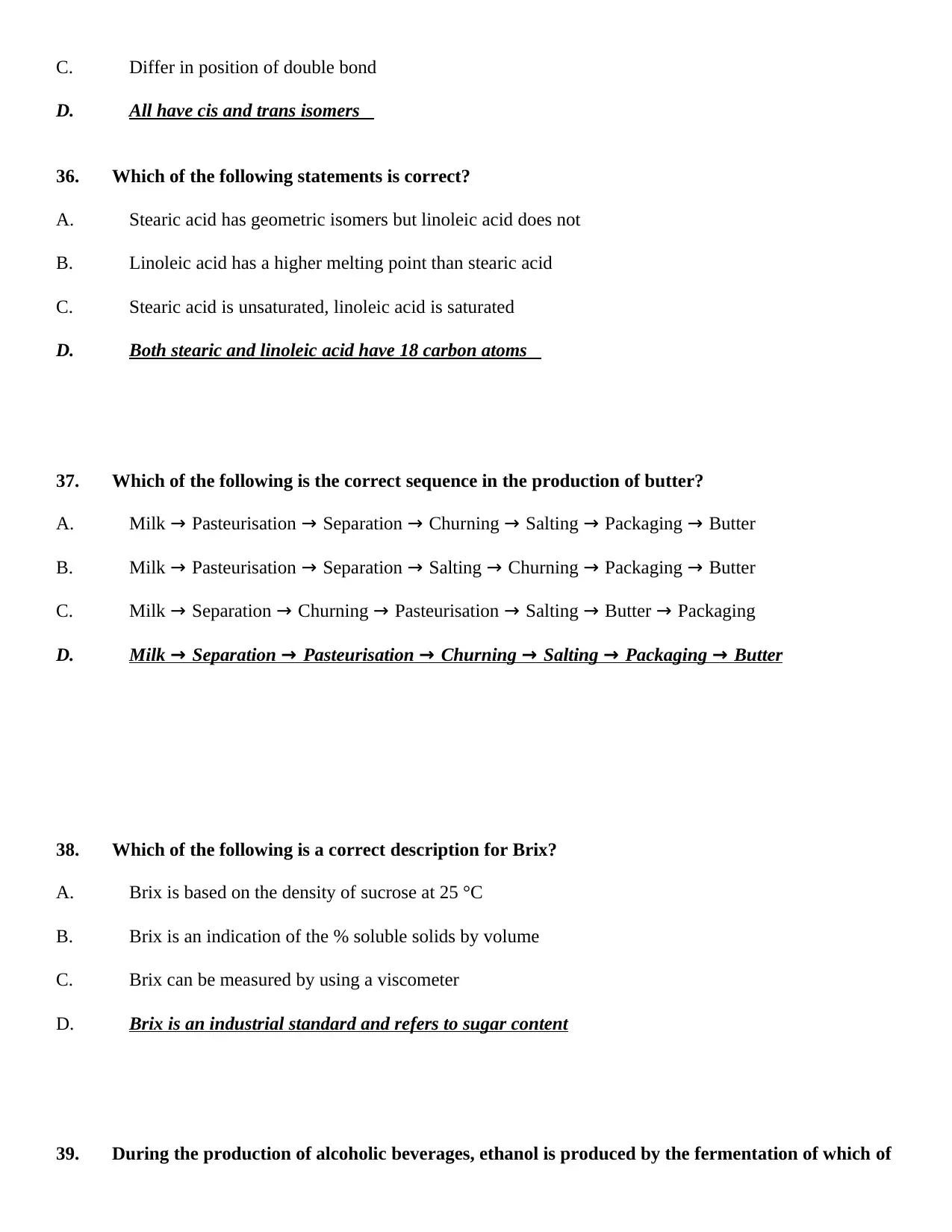
C. Differ in position of double bond
D. All have cis and trans isomers
36. Which of the following statements is correct?
A. Stearic acid has geometric isomers but linoleic acid does not
B. Linoleic acid has a higher melting point than stearic acid
C. Stearic acid is unsaturated, linoleic acid is saturated
D. Both stearic and linoleic acid have 18 carbon atoms
37. Which of the following is the correct sequence in the production of butter?
A. Milk → Pasteurisation → Separation → Churning → Salting → Packaging → Butter
B. Milk → Pasteurisation → Separation → Salting → Churning → Packaging → Butter
C. Milk → Separation → Churning → Pasteurisation → Salting → Butter → Packaging
D. Milk → Separation → Pasteurisation → Churning → Salting → Packaging → Butter
38. Which of the following is a correct description for Brix?
A. Brix is based on the density of sucrose at 25 °C
B. Brix is an indication of the % soluble solids by volume
C. Brix can be measured by using a viscometer
D. Brix is an industrial standard and refers to sugar content
39. During the production of alcoholic beverages, ethanol is produced by the fermentation of which of
D. All have cis and trans isomers
36. Which of the following statements is correct?
A. Stearic acid has geometric isomers but linoleic acid does not
B. Linoleic acid has a higher melting point than stearic acid
C. Stearic acid is unsaturated, linoleic acid is saturated
D. Both stearic and linoleic acid have 18 carbon atoms
37. Which of the following is the correct sequence in the production of butter?
A. Milk → Pasteurisation → Separation → Churning → Salting → Packaging → Butter
B. Milk → Pasteurisation → Separation → Salting → Churning → Packaging → Butter
C. Milk → Separation → Churning → Pasteurisation → Salting → Butter → Packaging
D. Milk → Separation → Pasteurisation → Churning → Salting → Packaging → Butter
38. Which of the following is a correct description for Brix?
A. Brix is based on the density of sucrose at 25 °C
B. Brix is an indication of the % soluble solids by volume
C. Brix can be measured by using a viscometer
D. Brix is an industrial standard and refers to sugar content
39. During the production of alcoholic beverages, ethanol is produced by the fermentation of which of
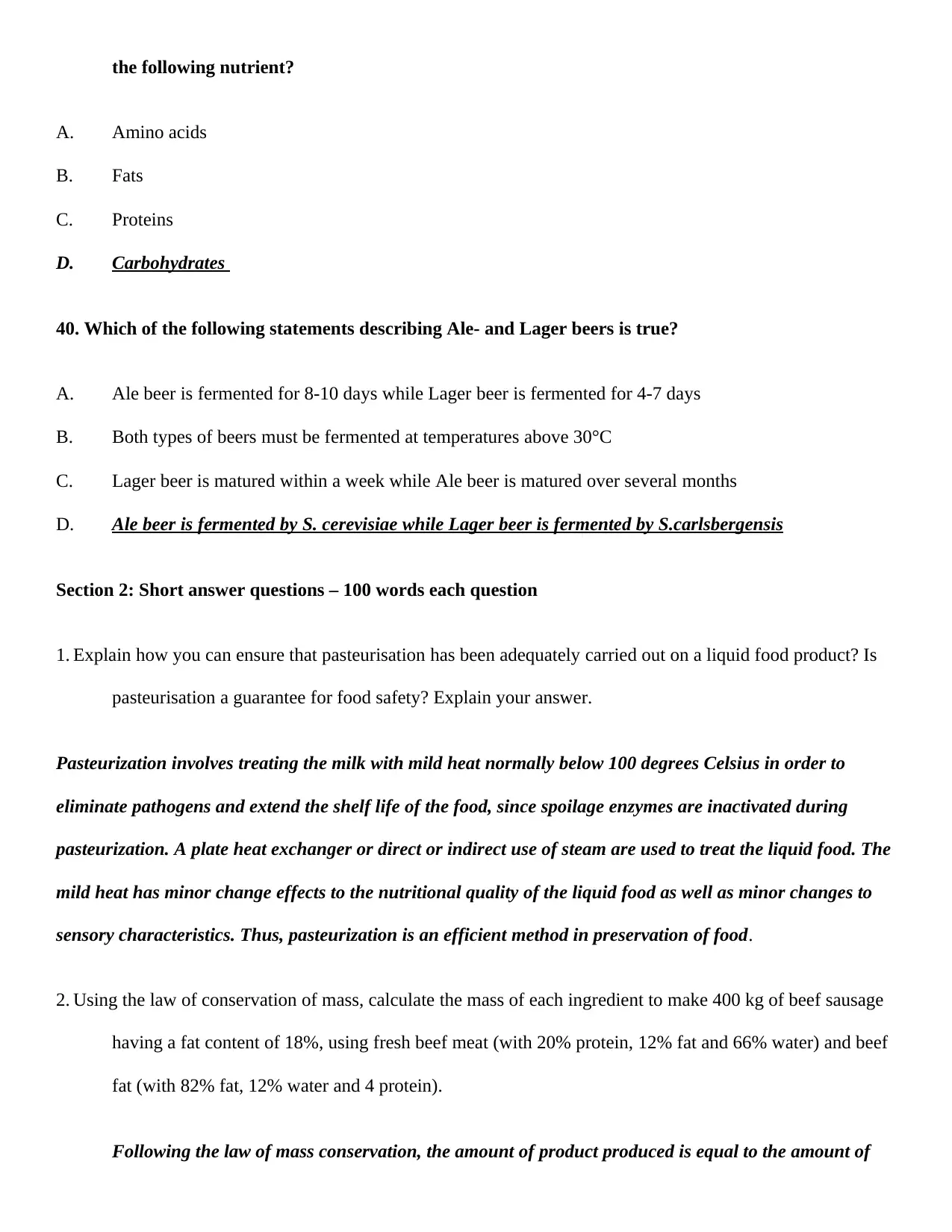
the following nutrient?
A. Amino acids
B. Fats
C. Proteins
D. Carbohydrates
40. Which of the following statements describing Ale- and Lager beers is true?
A. Ale beer is fermented for 8-10 days while Lager beer is fermented for 4-7 days
B. Both types of beers must be fermented at temperatures above 30°C
C. Lager beer is matured within a week while Ale beer is matured over several months
D. Ale beer is fermented by S. cerevisiae while Lager beer is fermented by S.carlsbergensis
Section 2: Short answer questions – 100 words each question
1. Explain how you can ensure that pasteurisation has been adequately carried out on a liquid food product? Is
pasteurisation a guarantee for food safety? Explain your answer.
Pasteurization involves treating the milk with mild heat normally below 100 degrees Celsius in order to
eliminate pathogens and extend the shelf life of the food, since spoilage enzymes are inactivated during
pasteurization. A plate heat exchanger or direct or indirect use of steam are used to treat the liquid food. The
mild heat has minor change effects to the nutritional quality of the liquid food as well as minor changes to
sensory characteristics. Thus, pasteurization is an efficient method in preservation of food.
2. Using the law of conservation of mass, calculate the mass of each ingredient to make 400 kg of beef sausage
having a fat content of 18%, using fresh beef meat (with 20% protein, 12% fat and 66% water) and beef
fat (with 82% fat, 12% water and 4 protein).
Following the law of mass conservation, the amount of product produced is equal to the amount of
A. Amino acids
B. Fats
C. Proteins
D. Carbohydrates
40. Which of the following statements describing Ale- and Lager beers is true?
A. Ale beer is fermented for 8-10 days while Lager beer is fermented for 4-7 days
B. Both types of beers must be fermented at temperatures above 30°C
C. Lager beer is matured within a week while Ale beer is matured over several months
D. Ale beer is fermented by S. cerevisiae while Lager beer is fermented by S.carlsbergensis
Section 2: Short answer questions – 100 words each question
1. Explain how you can ensure that pasteurisation has been adequately carried out on a liquid food product? Is
pasteurisation a guarantee for food safety? Explain your answer.
Pasteurization involves treating the milk with mild heat normally below 100 degrees Celsius in order to
eliminate pathogens and extend the shelf life of the food, since spoilage enzymes are inactivated during
pasteurization. A plate heat exchanger or direct or indirect use of steam are used to treat the liquid food. The
mild heat has minor change effects to the nutritional quality of the liquid food as well as minor changes to
sensory characteristics. Thus, pasteurization is an efficient method in preservation of food.
2. Using the law of conservation of mass, calculate the mass of each ingredient to make 400 kg of beef sausage
having a fat content of 18%, using fresh beef meat (with 20% protein, 12% fat and 66% water) and beef
fat (with 82% fat, 12% water and 4 protein).
Following the law of mass conservation, the amount of product produced is equal to the amount of
⊘ This is a preview!⊘
Do you want full access?
Subscribe today to unlock all pages.

Trusted by 1+ million students worldwide
1 out of 24
Your All-in-One AI-Powered Toolkit for Academic Success.
+13062052269
info@desklib.com
Available 24*7 on WhatsApp / Email
![[object Object]](/_next/static/media/star-bottom.7253800d.svg)
Unlock your academic potential
Copyright © 2020–2025 A2Z Services. All Rights Reserved. Developed and managed by ZUCOL.